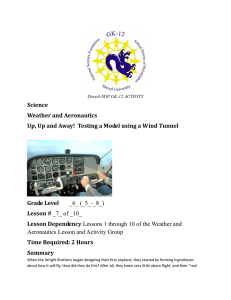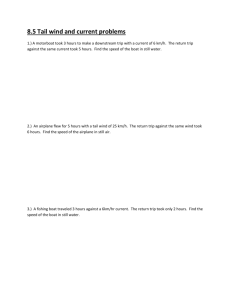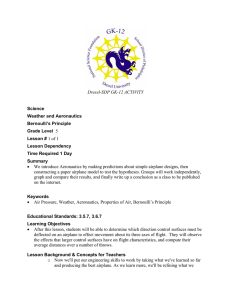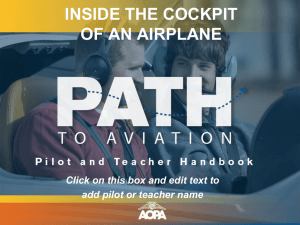Document 10519427
advertisement
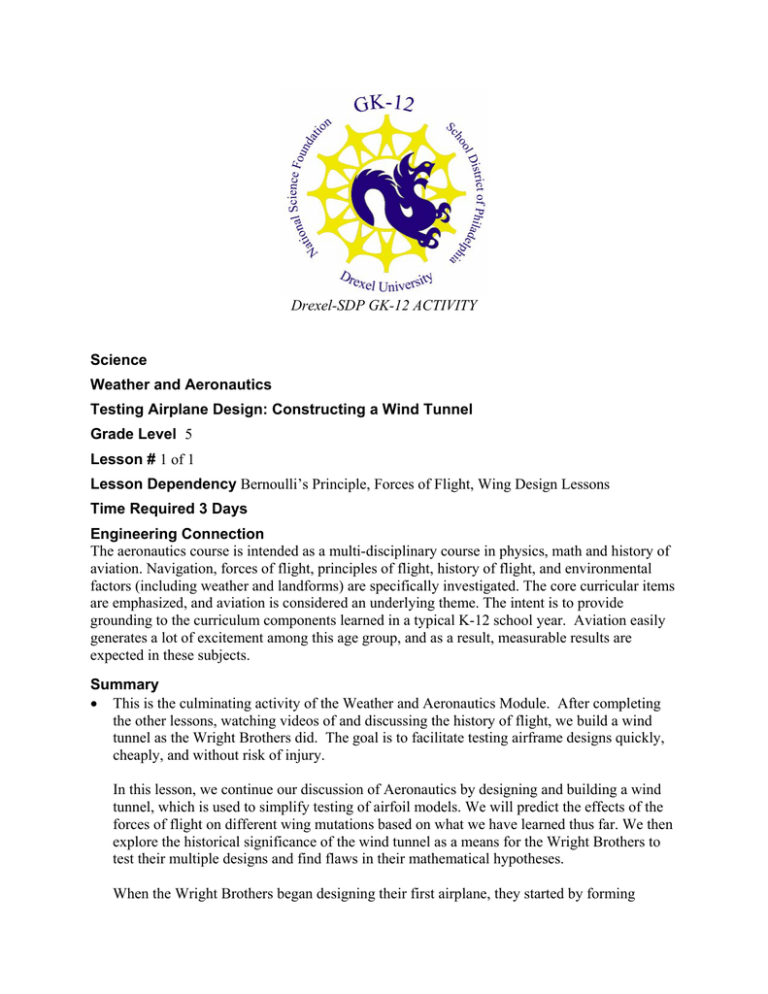
Drexel-SDP GK-12 ACTIVITY Science Weather and Aeronautics Testing Airplane Design: Constructing a Wind Tunnel Grade Level 5 Lesson # 1 of 1 Lesson Dependency Bernoulli’s Principle, Forces of Flight, Wing Design Lessons Time Required 3 Days Engineering Connection The aeronautics course is intended as a multi-disciplinary course in physics, math and history of aviation. Navigation, forces of flight, principles of flight, history of flight, and environmental factors (including weather and landforms) are specifically investigated. The core curricular items are emphasized, and aviation is considered an underlying theme. The intent is to provide grounding to the curriculum components learned in a typical K-12 school year. Aviation easily generates a lot of excitement among this age group, and as a result, measurable results are expected in these subjects. Summary • This is the culminating activity of the Weather and Aeronautics Module. After completing the other lessons, watching videos of and discussing the history of flight, we build a wind tunnel as the Wright Brothers did. The goal is to facilitate testing airframe designs quickly, cheaply, and without risk of injury. In this lesson, we continue our discussion of Aeronautics by designing and building a wind tunnel, which is used to simplify testing of airfoil models. We will predict the effects of the forces of flight on different wing mutations based on what we have learned thus far. We then explore the historical significance of the wind tunnel as a means for the Wright Brothers to test their multiple designs and find flaws in their mathematical hypotheses. When the Wright Brothers began designing their first airplane, they started by forming hypotheses about how it will fly. How did they do this? After all, they knew very little about flight, and their "real job" was actually making bicycles on the ground. They made their predictions using math. It turns out that mathematical equations can predict how much air pressure is needed to make the wing's lift equal its weight (and make it float). Do you think their results were perfect? In fact, they were far from perfect -- and sometimes downright wrong. They went out onto a beach in Kitty Hawk and tried their design, and even got hurt because of their mistakes. It wasn't until later that they discovered their error by realizing that their designs just didn't work. But, considering that they were actually trying to fly an airplane by trial and error, they really didn't want to spend all that time taking their model outside only to get hurt again when they fall. How could they solve this? They had to be a little clever. They built a wind tunnel that they would use to simulate the airplane moving through the sky. Instead of moving the airplane, they will move the air in a tunnel. Picture putting a fan into a tunnel and pointing it at an airplane. It should work! And if they alter the wing designs, they should be able to see the plane turn from left to right and go up and down. What would you change on an airplane to make it move in every direction? This week, you will build a wind tunnel and a model airplane. You will add moveable parts to the plane to create ailerons, elevators, and rudder. Let's label them now so that we know what they really are. What do you think will happen when we move each one? Keywords Aeronautics, Wind Tunnel, Wright Brothers, History of Flight Educational Standards: 3.5.7, 3.6.7 Learning Objectives • Students will build a wind tunnel and test control surfaces of a balsa wood airplane model. They will appreciate the historical significance of and demand for a wind tunnel during the race to get airborne in the early 20th century. Procedure o The Wind Tunnel Cut holes in each of the "egg slots" of the egg carton. Why do you think we are doing this? It is to allow the air to flow in a straight line through the tunnel, rather than in a vortex as it does out of the fan. This will simulate true airflow to the airplane surfaces. Tape the egg carton into the box and try to seal it off to the rest of the box. Make a window on the side of the box where the airplane will go. Use scissors to cut the box (don't cut too big!), and tape to attach the window. This is so we can watch what happens. Attach hooks at the top and bottom of the box where the airplane will go (so that it appears in the window). Attach the string or rubber band to the airplane and attach it to the hooks. 2 o The Airplane Building the model or using an existing model airplane, attach index cards or extra wood to the ailerons, elevators, and rudder of the plane. Predict what will happen when you rotate each surface one at a time, and try it! Record what happens and whether or not you were right. What if you move two surfaces at the same time? For example, try moving both ailerons in the same direction. How about different directions. How does the rudder work differently from the ailerons? What did each do? References o Procedure adapted from: NASA Explorers http://media.nasaexplores.com/lessons/01-059/5-8_1.pdf o Materials List: Franklin Institute http://sln.fi.edu/flights/first/makesimple/index.html Author William Mongan Date 9/11/2007 3
